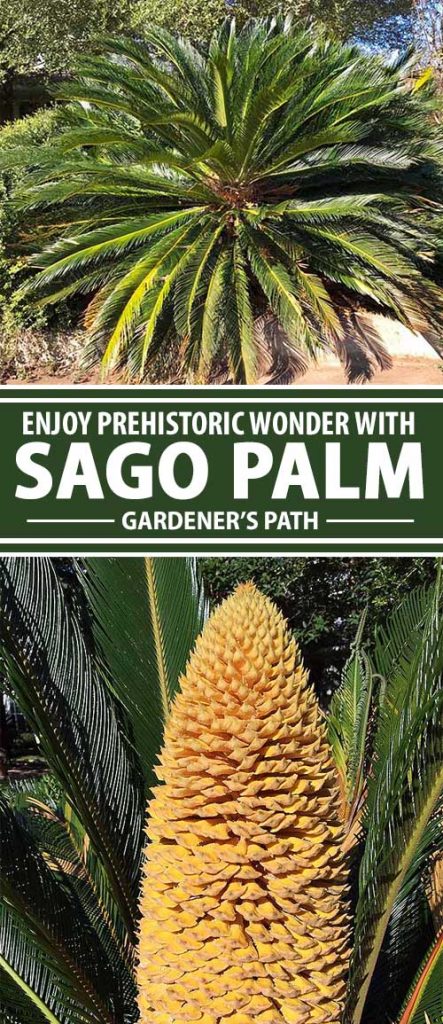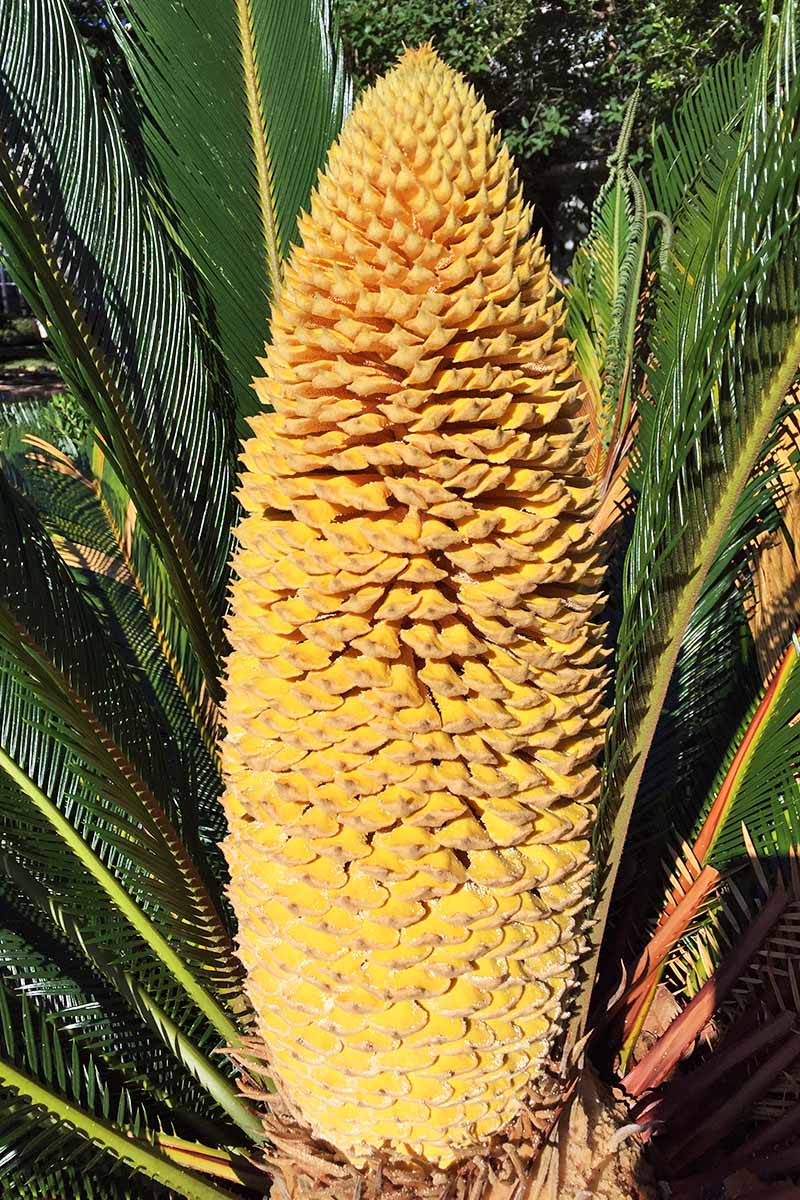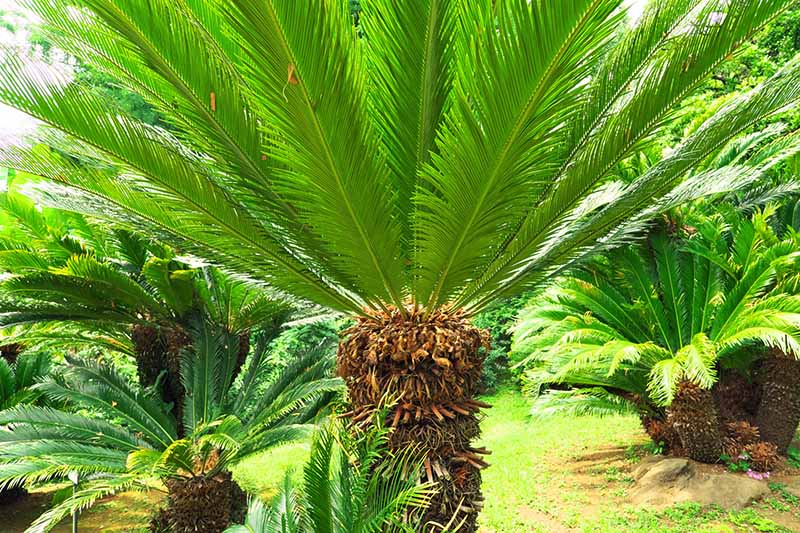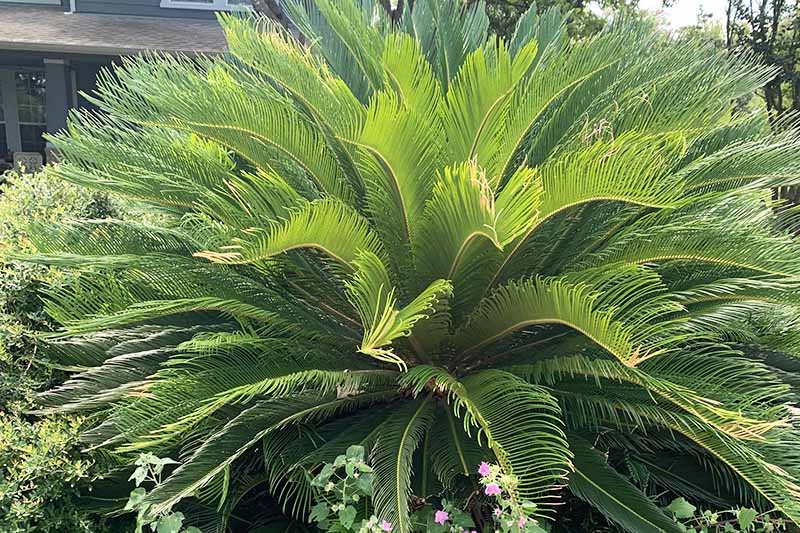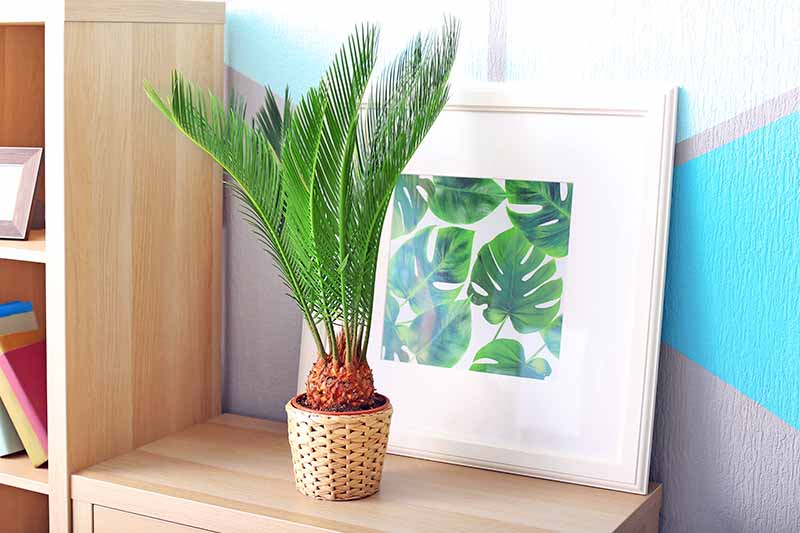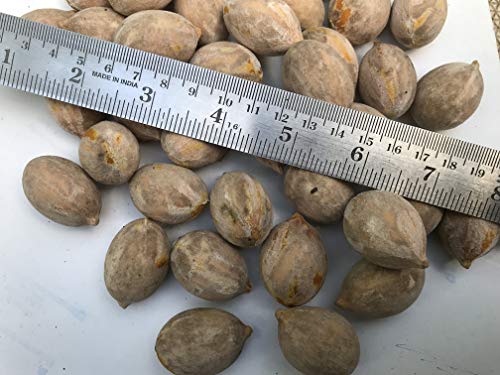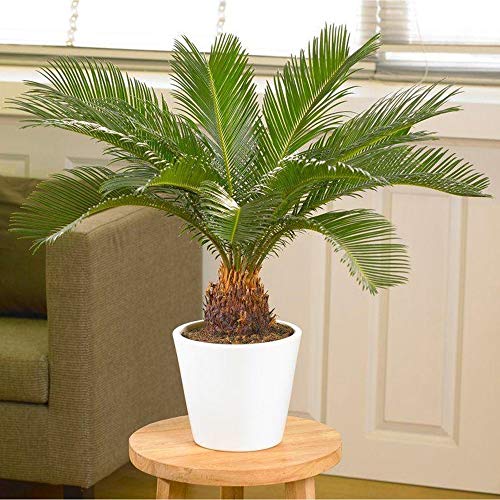The Cycad genus in the Cycadaceae family includes over 100 species, with the most common being Cycas revoluta or the king sago, the main focus of this article. Like ferns, these giant beauties have been around since before the dinosaurs, and their stunning display is truly evocative of an age long gone. In fact, they’re sometimes referred to as “living fossils,” dating back to the early Mesozoic Era without much change since then. We link to vendors to help you find relevant products. If you buy from one of our links, we may earn a commission. Here’s what’s to come in this article: Let’s learn more!
Cultivation and History
While “palm” is part of their common name, sago palms are not really palms at all. They’re cycads, a group of seed plants with ancient roots related to cone-bearing conifers. Other names for this type of sago palm include king sago, palm cycad, or Japanese funeral palm. Native to the southernmost island of Japan, the leaves were traditionally used in funeral arrangements in the Land of the Rising Sun. C. circinalis, or queen sago, is another common species that is native to India. It’s commonly grown in parts of Asia and Hawaii. This is not to be confused with C. micronesica, another species that is found in Micronesia, Palau, and Guam. This species gained notoriety when it was found to be linked to Lytico-Bodig disease, which is similar to ALS. The seeds of C. micronesica were a traditional food source on Guam until the 1960s, but they contain a potentially dangerous neurotoxin and should not be consumed. Sago grows slowly when confined to a pot, and it is also a favorite choice for bonsai.
Gardeners located within or north of USDA Hardiness Zone 8a must grow these ancient wonders in pots and bring them indoors to overwinter, but those of us in Zones 8a to 11b get to enjoy them in our landscapes year-round. When grown outdoors, C. revoluta may reach a height of 10 to 12 feet, though the ones I see in Austin are closer to about five feet tall. Here they are also typically allowed to fall into a spreading, half-round form, rather than the more upright, palm tree-like form that results when the lower fronds are trimmed off. The pinnate leaves are typically about four to five feet long at maturity, reaching their greatest length when grown in partial shade. Shiny, new leaves sprout from the top of the crown in a circular pattern, located above a woody trunk. As mentioned above, sago palms are poisonous to humans and pets, something to keep in mind if you have a dog who likes to experiment with new cuisines. Our dogs have never bothered our sagos, and the spiky leaf tips act as a deterrent as well. Each sago palm is either male or female. In late spring, males may produce a 12- to 24-inch-tall cone, whereas females produce a leaf structure resembling a basket that produces ovules. The “basket” opens when the plant is ready to be fertilized by pollen from the male, carried by wind or insects. Keep in mind that sago palms may take over a decade to reach maturity and bloom for the first time. This will only happen under ideal growing conditions, every three years or so.
Propagation
C. revoluta can be propagated via division, as well as growing by seed.
Division
For the first method, you may notice new clusters forming near the base of the plant. These pups can be cut off and planted elsewhere, or shared with fellow gardeners. Don’t procrastinate if you are going to attempt this process. Once the pups get too large, it’s very difficult to successfully propagate them. Get them before they’re a foot tall. In the spring or fall, clear the dirt from around the base of each pup. Grasp the base of a pup and gently wiggle it to pop it off. If it has already grown too large, you may have to cut it off with a clean, sharp gardening knife. Pinch or cut off any leaves that are sprouting from the pup. Place separated pups in the shade for a week to heal the wound, then choose a pot that’s a couple inches larger in diameter than the pup. Fill the pot with a fast-draining blend of sand, perlite, and peat moss, or a container mix that’s suitable for palms. Dig a hole and place the pup in the hole with the wound side down.
Water thoroughly, and let the soil dry out before watering again. Keep in the shade and away from bright sunlight until it has rooted, and note that this can take several months.
Seed
You can also propagate these ancient beauties from seed. In a small pot, press the seed into the soil with the flat side up, keeping about one-third of the seed above soil level, and place the pot in a warm area. Plant one seed per pot, to give it room to grow. Tamp the soil down around the seed, water well, and cover the pot with plastic to create a mini greenhouse that locks in warmth and moisture. Sago seeds will germinate in temperatures of 70 to 100°F, so leave them in a warm, sunny location or use a heat mat. Be patient – they can take up to three months to germinate. Keep the soil moist, and when the seed germinates, you can remove the plastic wrap. If you live in a hospitable area, you can plant the palms in the ground in early spring or late fall, after about three years once a strong root system has had time to develop. Otherwise, repot into successively larger containers as your cycad grows larger. Small specimens are perfect for bonsai!
To save your own seeds – or if you have a neighbor with mature female sagos – wait until fall to harvest them when the fruit is ripe. Wearing gloves, collect the orange fruit. You can tell the viable seeds from the unfertilized ones by placing them in a bucket of water; save the seeds that sink and discard the rest. Collected seeds can be stored at room temperature in an airtight bag or container. Before planting, allow them to soak in water overnight to soften their outer coating. Rinse well before potting up.
How to Grow
C. revoluta can tolerate full sun, and will do well in partially shaded areas in particularly hot and dry climates, where it will likely produce longer leaves. Bright light is required for growing indoors. Leaf damage due to both extreme heat and sun or extreme cold can cause damage to your cycads, leaving them susceptible to disease. When in doubt, give them some shade and protection. And don’t crowd your sagos in with other plants, to promote good airflow. They aren’t picky about soil. Mine have thrived in average, non-amended garden soil for years. For healthy, vibrant sagos, well-draining sandy soil is best.
Outdoor sagos are fairly drought-tolerant, and can go weeks without supplemental water and work great for xeriscaping in warm, dry climates. In fact, you should allow your plants to dry out between watering, plant only in well-draining pots, and avoid overwatering whenever possible. Sago palms don’t like wet feet, and a well-intentioned watering-happy gardener can unwittingly cause their plants to become susceptible to disease. No supplemental fertilizer is typically needed either. I’ve found that mine grow well in the native soil, with no need for amending of any kind. Once a month during the growing season, an 18-8-18 water-soluble fertilizer may be applied to keep your sagos at their best, at a rate of one teaspoon per gallon of water, or according to package directions. Regular applications of fertilizer will help to encourage C. revoluta to bloom, and produce new growth. Palm or citrus fertilizer may be used effectively on cycads as well.
Growing Tips
Plant in well-draining, sandy soil Drought tolerant, requiring infrequent watering Supplement with fertilizer once a month, except when dormant Bring container plants indoors for the winter in hardiness zones 8a and lower
Pruning and Maintenance
Evergreen C. revoluta requires little maintenance. Here in Austin, my sagos have suffered leaf burn during a couple of winters when temperatures sank into the low 20s for one or two nights, but otherwise, they overwinter in my growing zone perfectly well. Established plants grown outdoors may be covered with burlap for protection in rare cases of extreme winter weather. Dead fronds can be removed with sanitized pruners. Remember to wear gardening gloves when you are doing this, to avoid jabs from the sharp, pointed leaf tips. To improve the look of the plant, you may also choose to carefully cut away withered fruit and flower stalks at the end of the season, for seed saving or disposal. Keep in mind that pruning is only recommended for brown, dry fronds that have died. You may be tempted to remove yellowing fronds, particularly if you feel they ruin the green, lush appearance. Here’s what I have to say to that: don’t! Removal of these fronds, especially when yellow portions are found towards the bottom of the plant, can actually cause stress. And this can lead to stunted growth, or make your plants susceptible to infection. Yellow fronds are still alive and absorbing nutrients, and removal may actually cause the problem to spread up the plant in cases where this is a sign of disease. See the section below on managing pests and diseases for additional suggestions and information. Over the years, as your sago palm matures, you may choose to prune it into a tree form rather than a rounded bush with lower leaves that touch the ground. This must be done gradually over the course of years, in order to avoid undue stress. Remove the oldest fronds from the base sparingly, cutting as closely to the trunk as possible.
Managing Pests and Diseases
Sagos are pretty hardy, and they should do well in your garden with proper care if planted in a suitable location. C. Revoluta, 10 Seeds If you don’t have a local retail source available, or a friendly neighbor who saved some fruit or pups for you, you still have options. King Sago Palm 6-Inch Live Plant, 1-Gallon Pot
Sago Palm 8- to 12-Inch Live Plant, 3-Gallon Pot And if you want an ever larger specimen, you can find live plants in three-gallon pots available from Fast Growing Trees. A few potential pests and problems that you may encounter include scale insects, yellowing, sooty mold, and various types of rot. If you’ve ever had aphids take over your rose bushes, you’re probably familiar with the honeydew that they excrete, and the unsightly mold that can grow on your plants as a result. Scale bugs can cause similar issues when they attack your cycads. They might be poisonous to humans and pets, but certain species of these insects love them! We cover this problem and more in our guide on sago palm pests and diseases that might affect them, with preventive measures that you can take to protect your garden and suggested techniques for control, including the use of beneficial insects and integrative pest management techniques.
Best Uses
In addition to serving as a gorgeous ornamental that remains green throughout the year both indoors and out, I’ve found a decorative use for those aging portions of my C. revoluta as well. I just cut out the “burned,” dry brown fronds and place them decoratively in a large planter on my porch. The original plant is fine, and I have the added bonus of a nice dried arrangement. The dried fronds are fairly “pokey” though, so displays should be placed in a low-traffic area. And do not used diseased portions of plants for decoration, as any fungal growth or insects present may spread to other parts of the garden. Dispose of these appropriately. Remember: No portions of the sago palm may be eaten. If you’re looking for an edible option for the backyard with unusual fruit, maybe the loquat is for you.
Quick Reference Growing Chart
Where Will You Plant Yours?
While C. revoluta makes a spectacular landscape plant for those of us in the southern United States, gardeners in other parts of the country can enjoy these prehistoric wonders indoors.
Sun or shade, good dirt or bad, this dramatic palm-like plant loves hot climates and rewards with a singular display. Are you looking for more drought tolerant perennials? Some of these guides might be right up your alley:
How to Grow Turpentine Bush: the Desert Dazzler How to Grow Texas Mountain Laurel Grow Mexican Petunias (Ruellia Simplex) for a Heat and Shade Tolerant Perennial
